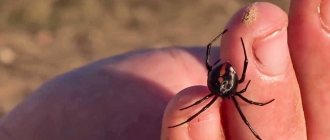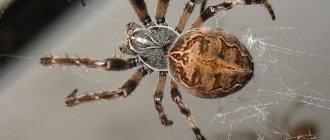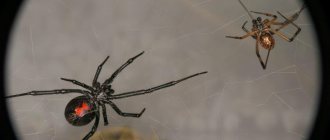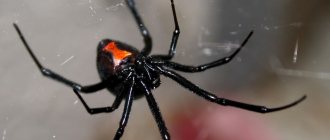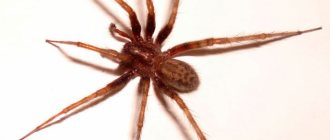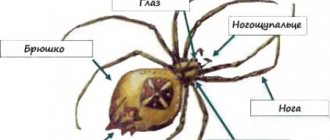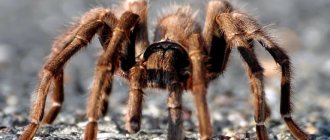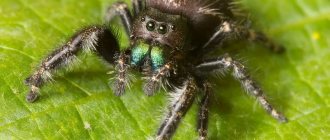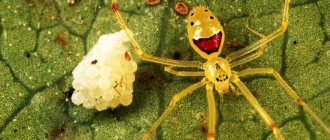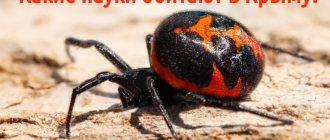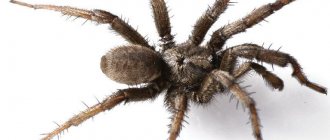According to various sources, the order of spiders numbers from 20 to 40 thousand species. All of them are poisonous, with a few exceptions, but only a few pose a danger to humans.
It is worth noting that even the bites of the most poisonous spiders are usually “empty” and do not cause harm to health. The toxicity and amount of poison is designed to infect small insects and animals.
Based on their effect on the body, spider venoms can be divided into two categories:
- Necrotic - cause damage to cells and tissues, externally manifested in the form of rashes, blisters, ulcers. In rare cases, gangrene develops.
- Neurotoxic - affect the nervous system, interfere with the transmission of signals by nerve cells or stimulate them. In extreme cases, they can cause respiratory and cardiac arrest.
In some species, the venom may contain both necrotic and neurotoxic components. An infection that can enter the body through a bite and an allergic reaction are also dangerous.
Funnel Spiders
It is noteworthy that the venom of strong atrax is dangerous primarily for humans and primates, while it does not have such a toxic effect on other mammals, such as dogs and cats.
Funnel web spiders are found in Australia. Many are potentially dangerous, but two species are of particular medical importance: the Sydney funnel-web spider (Atrax robustus) and the northern tree funnel-web spider (Hadronyche formidabilis).
Since 1981, when the antidote became available to doctors, not a single death has been reported. Over the previous 50 years, 13 people, 7 of whom were children, died from funnel-web spider bites.
The body length of funnel-shaped spiders can reach 5 cm. They are notable for the fact that they construct trapping nets in the shape of a funnel. The Sydney spider is on the ground, and the arboreal spider is at a height of about 30 m in the crowns. They feed on large insects and other spiders. Males bite more often.
Symptoms of poisoning appear within 15-20 minutes after the bite and include: local pain, increased sweating, hypertension, tachycardia, muscle spasm, nausea and vomiting, difficulty breathing, disorientation and confusion. Sometimes pulmonary edema develops. According to some reports, Atrax the Strong is the most dangerous spider in the world.
To obtain one dose of antivenom, the tree funnel-web spider must be milked approximately 70 times.
Tarantula
Tarantulas (lat. Lycosa) are a genus of poisonous and large (3.5 cm in length) araneomorphic spiders belonging to the family of wolf spiders (lat. Lycosidae). They live in almost all warm parts of the world. They are also long-lived spiders (lives more than 30 years).
flickr/andreafrassinetti
Tarantulas feed on insects, small amphibians, and can attack small rodents. It has a toxic poison that is fatal to many animals. However, people never died from its bite.
Black widows
For a long time, the Black Widow was considered the most poisonous spider on Earth.
Black widows are common in South and North America. They are easily recognized by the red hourglass-shaped spot on their abdomen on a glossy black background.
A black widow's bite feels like a pin prick. After some time, two red dots and local swelling appear. After 30-60 minutes, painful muscle spasms begin, which spread from the site of the bite to the large muscles of the limbs and torso, then severe tension in the muscles of the anterior abdominal wall and severe pain in the abdominal area occur. Other symptoms include: increased salivation, sweating, vomiting, hypertension, tachycardia, shortness of breath, headache, weakness, urinary incontinence. Rarely, renal failure develops. The pain begins to subside within the first 12 hours and may return periodically in the following days and weeks. Side effects associated with an allergic reaction are possible. 0.5% of all black widow bites are fatal.
How do black widows reproduce?
A black widow spider spins silk for eggs. (Image credit: Department of Biology, University of California, Riverside)
According to Canadian Geographic, black widows are mostly solitary except in late spring when mating occurs. When ready to mate, males first spin silk, which they soak with sperm, and then coil appendages called palps near their head. When they find a receptive female, they insert their sperm-covered palps into her reproductive opening. ()
The female then creates egg sacs that can contain many hundreds of eggs, which hatch in about 30 days, according to the NCC. The spiderlings are whitish or pale yellow after hatching and darken with each moult; females reach maturity in about 90 days and live for about 180 days thereafter, while males mature in about 70 days and then live for another 30 days.
However, black widows Latrodectus mactans are known to live up to three years in the wild and up to four years in captivity. ()
Karakurt
In the habitats of this spider, livestock suffer greatly from bites. Camels and horses are especially sensitive to karakurt poison.
Karakurt is a species of spider from the genus of black widows. It can be immediately recognized by the 13 red dots on its abdomen. The habitat is extensive, karakurt is found in Near and Central Asia, the Mediterranean, North Africa, Southern Europe, southern Russia and Ukraine. Recently, bites have begun to be recorded more often, which is associated with an increase in the number of spiders.
Karakurt will not attack animals or humans unless disturbed. The poison, entering the body, acts slowly. The victim first feels a burning pain, which after 10-15 minutes spreads throughout the body. Next, spasms are observed in the abdomen, lower back, chest, and sharp tension in the abdominal muscles. Accompanying symptoms: shortness of breath, dizziness, tremor, vomiting, sweating, priapism in men, bronchospasm, uncontrolled urination and defecation.
Antikarakurt serum is used for treatment. During the first two minutes, Soviet zoologist P.I. Marikovsky suggested cauterizing the bite site with a flammable match head. When exposed to high temperatures, the poison is destroyed
Yellow sac spider
Cheiracanthium, or yellow-sac spider (lat. Cheiracanthium) is a poisonous spider from the family Miturgidae. It lives almost throughout Europe, but is quite rare, as it is very shy and tries to avoid meeting people. They usually hide in leaves rolled into a tube.
flickr/mcvmjr1971
Its venom is considered the most toxic among all European spiders. After being bitten by a yellow spider, you may experience nausea and headache for several days. You can only get a bite from this spider by accident - through negligence. The European species of these spiders are not dangerous, but after a bite from the southern species, non-healing abscesses remain for a long time.
Brown Widow
Like its brethren, the brown widow produces a neurotoxic venom that can cause a variety of symptoms known as latrodectism.
The Brown Widow has relatively thin legs and a deep, spherical abdomen. On the abdomen there are one or more red spots on the top or bottom. The spots may be shaped like an hourglass or several dots. Males are much smaller than females and less dangerous, but they can also bite.
Brown widow venom causes painful effects including muscle spasms, "tetanus" contractions, and in rare cases, spinal or cerebral palsy. It is usually temporary but can cause permanent damage to the central nervous system. The effects of the bite may require a short hospital stay. Children, elderly and sick people are more likely to suffer serious consequences.
Hermit spider
One of the most poisonous spiders in the United States sometimes lives in residential buildings
Hermit spider ( Loxosceles reclusa
) lives mainly in the southeastern United States, it is considered one of the most dangerous to humans. It is also called the violinist spider because of the violin-like pattern on its cephalothorax. The poison causes tissue necrosis. Sometimes an ulcer forms at the site of the bite, which does not heal for several months. Fortunately, this spider is not aggressive and rarely attacks humans. Two deaths are known.
The moment of the bite is similar to a needle prick and often goes unnoticed; within 2-8 hours the first symptoms make themselves felt: a painful, itchy swelling develops. The further development of arachnosis depends on the amount of poison and the condition of the victim. In severe cases, extensive necrosis of the skin and subcutaneous tissue is observed.
Six-eyed sand spider
The six-eyed sand spider (lat. Sicarius hahni) is considered one of the most dangerous spiders. Lives in South America and southern Africa. Sets up ambushes, hiding in the sand. It attacks the victim with lightning speed, injecting its deadly poison into it. They prefer to hide among sand dunes, under stones and snags or tree roots.
flickr/markusOulehla
Most often, these spiders themselves avoid meeting people, but if given the chance, they will definitely bite. They are among the five most dangerous spiders on our planet. The toxin in the venom of the six-eyed spider causes ruptures in the walls of blood vessels, which leads to serious internal bleeding. An antidote has not yet been found, but despite this, only two cases are known in which people died from the bite of these spiders.
Yellow sac spider
In Germany, it is the only poisonous spider.
Found from Central Europe to Central Asia. In 2022 and 2019 cases of bites of the Cheiracanthium species have been recorded in Bashkortostan, Tatarstan, Kazakhstan and Ukraine, as well as in Russia, in the Chelyabinsk and Orenburg regions.
Yellow sac spiders are small, only about 1.5 cm. The bite is similar to a wasp sting, perhaps a little more painful. Some people experience more severe reactions, such as nausea, headache, and dizziness. Necrosis sometimes develops at the site of venom injection, as after a recluse spider bite.
Where do poisonous spiders live?
Poisonous arachnids live throughout the world. They usually choose insects and animals as their victims, and bite people only if they feel they are in danger.
Poisonous spiders live on almost all continents of the world. Most often, deadly representatives of the arachnid class can be found in Australia, and in most of Russia such individuals live only in small numbers.
Brazilian wandering spider
The amount of venom released during the bite of a Brazilian wandering spider is tens of times higher than that of the karakurt, although the venom itself is less toxic.
The Brazilian Wandering Spider or Banana Spider was listed in the Guinness Book of Records in 2010 as the most venomous spider in the world. The banana spider's range covers tropical South and Central America. Painkillers are made from banana spider venom. In Brazil, 10 deaths have been reported due to bites from Phoneutria spiders.
The venom contains a powerful neurotoxin; in most cases, the bite goes unnoticed, but in toxic concentrations it causes loss of muscle control, followed by paralysis and suffocation. The bite is of medium pain. The poison instantly irritates the lymphatic system and enters the bloodstream. In 85% of cases it leads to numbness of the limbs. In men it sometimes causes priapism (painful erection).
It is extremely rare for a wandering spider to travel from Latin America to Europe in banana boxes. In 2014, it was discovered in a London supermarket, and in 2015 it was found among bananas in the small French town of Passy.
Brazilian spider soldier
Brazilian soldier spiders (lat. Phoneutria) are fast, very active and, most importantly, poisonous animals. It is also called the armed or banana spider. It got its name due to the fact that it does not spin webs like most of its fellows, because it does not need it, as it prefers a nomadic lifestyle. He loves to enter human habitation, where he can hide in shoes, clothes or dishes.
flickr/Thiago G. Carvalho
He lives in South America. He hunts insects, other spiders and even birds, and loves to feast on bananas. The 10-centimeter predator has a toxic venom that can kill a child or weakened adult before help can be provided. The poison of some specimens can be so dangerous that a person can die in 20-30 minutes.
Wolf spider
Wolf spiders live in places with high humidity levels, in forest areas, near bodies of water, but sometimes they can run into houses
Wolf spiders are distributed everywhere, with the exception of the poles. They are hairy, brown or gray in color with various striped markings on the back and an unusual arrangement of eyes: four small eyes in the bottom row, two large ones in the middle and two medium eyes in the top row.
Wolf spiders do not spin webs. They are poisonous, very nimble, but not aggressive and are relatively safe for humans. A slight itchy swelling appears at the site of the bite, which usually goes away on its own and does not require treatment.
Six-Eyed Sand Spider
The six-eyed sand spider is a venomous spider of the Sicarius family. Distributed in South Africa, prefers desert or semi-desert areas. The spider has a fairly large body of a yellowish color.
Six-eyed sand spider: Wikipedia
The poison is dangerous for humans due to its pronounced necrotic effect. It quickly spreads throughout the body and affects tissues, causing them to die. In addition, the poison can destroy red blood cells, causing oxygen starvation of the body and death. However, there are only a few confirmed cases of death from sand spider bites.
Fringed Ornate Tarantula Spider
The genus name of this spider, Poecilotheria, comes from two Greek words “poikilos” - motley, and “therion” - wild beast. Another name is the decorated tarantula.
This spider from the tarantula family is one of the largest. Lives in Sri Lanka and India.
Unlike other tarantulas, Poecilotherium ornata is considered poisonous. Its bite can cause severe pain and muscle cramps. Painful symptoms can last up to 2 weeks. There are no known deaths, but cases of coma have been reported.
Spiders are important for medicine. Their venom is used to make an antidote and a number of medicines. An anesthetic for severe cancer patients is made from the venom of wandering spiders. Thrombolytic agents are obtained from the venom of the fiddler spider. Tarantula venom is used in the manufacture of sedatives, and the venom of the Chilean rose tarantula, administered during a heart attack, reduces the risk of fibrillation.
Mouse spider
Mouse spiders (lat. Missulena) are spiders from the family Actinopodidae. A total of 11 species are known. Ten of them are considered endemic to Australia, the 11th species (lat. Missulena tussulena) lives in Chile. They got their name (English: mouse spiders) due to the erroneous idea that they supposedly dig deep holes like mice.
flickr/Volker Framenau
Mouse spiders prey on insects and other spiders. In addition, they themselves are food for wasps, scorpions, labiopods and bandicoots. The venom of this spider is protein in nature and is considered dangerous to humans. Fortunately, they are rarely found near human habitation.
